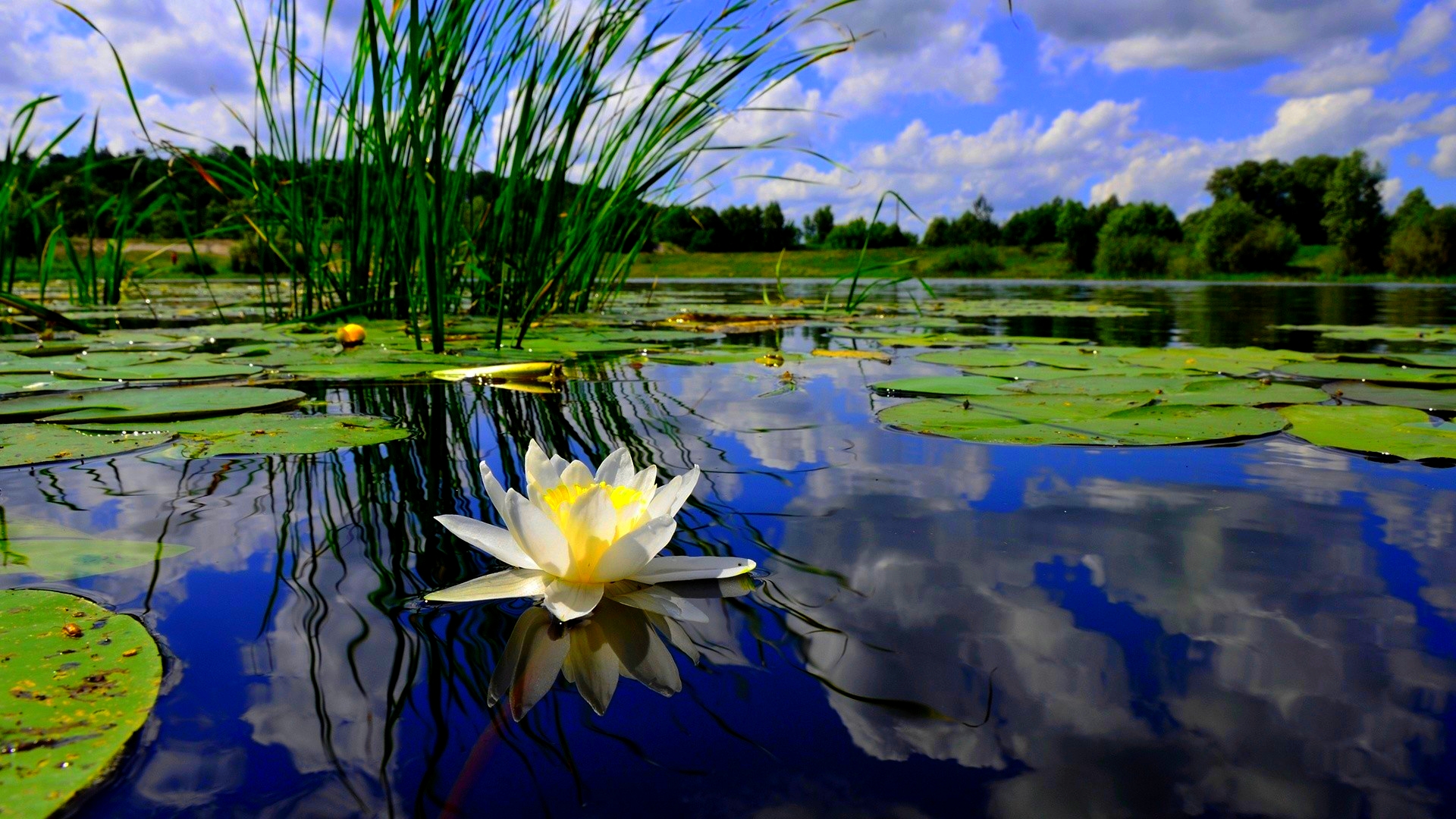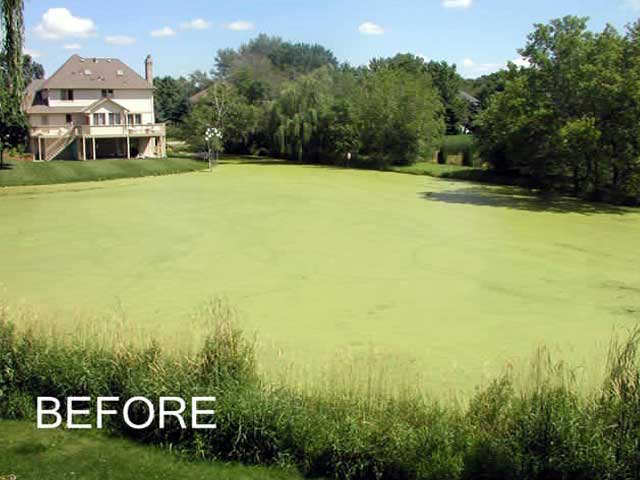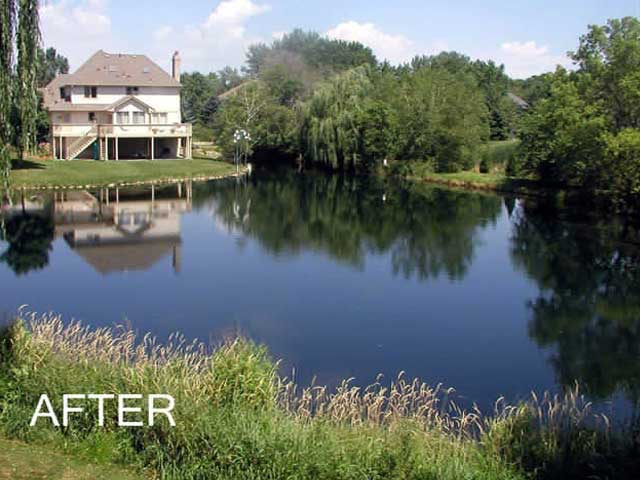Adding a Kasco pond aeration, aeration fountain or water circulation pump will help add oxygen and surface agitation to your pond or body of water and will help with algae problems. However, air conditioning and water movement is not cure-all or silver bullets for algae or water quality problems. As with many things in life, it’s all about balance and working with other items that yield the best results. There are several available methods for the prevention and algae, such as herbicides, bacteria and microbes, chemicals, UV sterilizers, and other additives, such as barley straw.
Each has a slightly different way of attacking algae and some may work better in different situations and applications. However, each is designed to help eliminate and prevent algae from growing. Some only treat one generation of algae blooms, others may work for a longer period of time. Either way, when the algae dies off from natural causes or from one of the above treatment methods, there will be a large oxygen demand and Kasco Aeration can help. Also, the added water movement and mixing helps evenly distribute the treatments used and often makes the treatment work more effectively.
Dyes : This is old technology but it can work. Dyes are available in blue or black, powder or liquid, and act to shade water and reduce sunlight penetration that feeds algae growth. Aquashade® is the only EPA registered product for weed and algae prevention, but most other products work, the just do not have the EPA registration. A side benefit that has been explored with some success is tinting the water blue or black to keep predacious birds from harvesting the fish in your pond because the birds cannot see the fish as easy. Aeration works great with dyes because it helps mix up the water and evenly distribute the dye that is added to the water. This method of treatment does not work well in ponds that are pumped from for purposes like irrigation or overflow into other ponds, because the dyes are removed during this process.
Bacteria and Enzymes : This is a non-chemical approach which basically involves living organisms feeding off of the excess nutrients that would otherwise be available for plant growth. Typically they are a concentrated blend of naturally occurring bacteria and enzymes that rapidly biodegrade sludge, improve water quality, decrease suspended particulate matter and solids, and control odor if used correctly in the proper blend for the pond. Many different products boasting fantastic results are out there for consumers. What is critical to the success of using this approach are a few basic guidelines:
- Bacteria are living organisms and if you use them in conjunction with herbicides there is a good chance they will prove to be marginally successful at best.
- Dissolved oxygen levels must be at least 2 ppm for effective aerobic activity.
- As the temperature drops, so does the effectiveness.
- pH range of most products is 5.5 to 8.5.
Ultraviolet Sterilizers : This product basically works by using a wavelength of light that will zap planktonic algae. It is very effective for green water, but will do nothing for filamentous or erect algae forms because they will not pass through the unit to be exposed to the light. It should be viewed as a fairly effective approach for watergardens and fairly small ponds, but not that effective for larger ponds because of the costs associated with the larger scale units and applications. Flow rates are readily available from any of the major manufacturers of this type of equipment and are measured by micro watts per second per centimeter squared.
Ultrasonic Sound Waves : The basic science behind these units is fairly sound. They use resonance of ultrasonic waves to kill algae. A submersed transducer generates ultrasonic waves that shock the algae and kill the algae by tearing the gas vacuole which allows them to float. This type of product should not harm your fish. The problem with this approach is that the cost for the unit is high and the results are highly variable and marginally successful at best. The biggest reason behind this is each pond should be looked at almost as a separate organism with varying water quality. A unit should then be sized for those conditions. The problem is that this type of approach does not lend itself to an off the shelf type of sale and more importantly, drives the cost up to the point where it is not feasible for many to spend that type of money on a product without knowing the chances of success.
Barley Straw : Barley straw has been used as a natural alternative to algaecides for centuries throughout England and Scotland. If it is to be sold as an algaecide here in the US, it must have an EPA registration number. Research has suggested that barley straw can aid in balancing the water quality by lowering the pH and carbonate hardness of the water, which can control the growth rate of certain undesirable plants and algae. As the straw degrades in the presence of water and sunlight, it creates peroxide, which can kill both filamentous and planktonic algae. It is better at deterring algae than controlling it once there is already a problem. Application rates area all over the board and success varies from pond to pond. A commonly recommended dosage for private ponds (this is how many get around the EPA registration problem) is 225 pounds of barley straw per acre of water (about 5 bales) in relatively shallow ponds of 4-5 feet deep. It is critical that the barley is loosely packed and that it gets some type of water circulation through the bales. Kasco aeration and circulation products can add this water movement and circulation needed for better success. The bales can also act as a substrate for beneficial bacteria to adhere to and grow. There are also several products, such as barley straw pellets and barley straw extract that can be added to your pond instead of the actually bales, but these products are more expensive.
Skimmers : There are several types of skimmers available on the market. Skimmers are usually not feasible in larger ponds or lakes, but work well in small applications such as watergardens. There are several manufacturers on the market that make skimmers as part of their pond kits that include filters, liners, pumps, etc. to create a watergarden. The skimmer collects water and floating plants and sends them through the attached filter. The filter takes out the plant material and returns the clean water.
Fish : Sterile grass carp have been used to effectively eliminate weeds within many ponds. Contrary to popular believe, they do not like to eat filamentous algae or any other types of algae. They are mentioned here because sometimes they are the cause of a species shift from rooted aquatic plants to a filamentous and planktonic algae dominated pond. The easiest way to understand this is to assume that the fish eat the plants, excrete the waste back into the pond and algae form as a result. The nitrogen and phosphorus that was in the rooted plants has not been removed and will manifest itself in algae, which are not desired by these fish. The questions is , do you want rooted plants or algae in your pond? Grass carp are not legal in every state so consult your regulatory agencies prior to stocking them.
Copper : Copper is usually the first answer most people get when they bring up the subject of algae control. Copper is toxic to certain species of fish within the minnow family as well as salmonids depending on the dosage and water chemistry. Water with high hardness and alkalinity buffers copper from being toxic, but also limits its effectiveness. The most common form of commercially available copper is granular copper sulfate. Its effectiveness and cost as a broad spectrum controller of planktonic and filamentous algae has led to its high usage. Liquid chelated copper products are used to control a broad range of algae including planktonic, filamentous, and bottom attached types of algae. Cutrine-Plus® is an example with application rates from 0.6 to 1.2 gallons per acre-foot of water treated. Consistent usage of some copper products can lead to bioaccumulation within the sediments and this approach is on the radar of some regulatory agencies, so a varied approach is probably the most sensible path to take.
Tilapia have been used to control blue green and filamentous algae in ponds, but they are a tropical fish and will start to “stress” when water temperatures drop into the 50’s. They are also not legal in every state and they are what they eat so there is a tendency for them to be off flavor if they are consuming a fair amount of plant material as a decent portion of their diet.
Reward® : This product is a diquat based, powerful herbicide/algaecide commonly used in natural ponds. It is safe to use according to the label for all types of algae control in natural ponds, but restrictions concerning fish harvest apply. This type of treatment works well with aeration to combat the negative effects of the algae die off.
Physically Removing Algae : This method is used for filamentous algae and erect algae and is very labor intensive. The benefit to this approach is that you remove nutrients with the plants which gets the fertilizers out of the water to temporarily stop the cycle of growth. People have used dip nets, rakes, pulled by hand, etc. Whatever works or whoever works because you will not have people lining up to pull out your algae. The “Algae Monster” at the top of the page has pulled out a few pounds of filamentous algae in his day.
Peroxides : Granular based peroxides are super fast acting contact algaecides for string algae and have been EPA approved within the last few years. Green Clean® is one of these products that has organic approval. It is fast acting and bubbles as it oxidizes similar to medical grade hydrogen peroxide. They byproduct is oxygen and it is safe for fish at the recommended dosages. The remaining filaments and cellulose must be taken out of the water or it will settle back to the bottom of the pond. It is a bit more expensive than some of the other products, but is amazing for spot treatment and does not leave any harmful residues. Application rates vary greatly so it is important to follow the label instructions. As a side benefit, it works well at cleaning algae off of tanks, aerators, sidewalks, and even roofs. This type of control method works well in small applications such as watergardens.
Binders : Aluminum Sulphate (Alum) and forms of alum have been used to clear up muddy or cloudy water and remove phosphorus. Barraclear® is a fairly new product with active ingredients of alum, bentonite clay, and a buffering agent to prevent pH change. It is not an algaecide or herbicide, but it binds phosphorus to starve the plants. The amount required is dependant on the phosphorus levels within your pond so it would be a good idea to get a phosphorus test kit and consult the label for application rates.
 sen lucht in beluchtingsslangen die op de bodem van de plas liggen. De luchtbellenschermen die zo ontstaan, brengen het water in beweging en zorgen voor stroming in het water. De blauwalgen, die in de bovenste waterlaag voldoende licht hebben om te groeien, worden door de stroming meegevoerd naar het diepe en donkere deel van de plas. Hierdoor worden de algen belemmerd in hun groei en de algenconcentraties in de plas wordt sterk teruggedrongen. Bovendien worden de algen die nog wel aanwezig zijn, verspreid over de waterkolom waardoor ze geen hinderlijke drijflagen meer vormen. Dit systeem is effectief in meren die dieper dan 15 à 20 meter zijn, omdat daar een grote donkere zone aanwezig is waar de groei van de blauwalgen kan worden gehinderd. Maar ook in ondiepere wateren wordt de Kasco apparatuur effectief toegepast.
sen lucht in beluchtingsslangen die op de bodem van de plas liggen. De luchtbellenschermen die zo ontstaan, brengen het water in beweging en zorgen voor stroming in het water. De blauwalgen, die in de bovenste waterlaag voldoende licht hebben om te groeien, worden door de stroming meegevoerd naar het diepe en donkere deel van de plas. Hierdoor worden de algen belemmerd in hun groei en de algenconcentraties in de plas wordt sterk teruggedrongen. Bovendien worden de algen die nog wel aanwezig zijn, verspreid over de waterkolom waardoor ze geen hinderlijke drijflagen meer vormen. Dit systeem is effectief in meren die dieper dan 15 à 20 meter zijn, omdat daar een grote donkere zone aanwezig is waar de groei van de blauwalgen kan worden gehinderd. Maar ook in ondiepere wateren wordt de Kasco apparatuur effectief toegepast.







